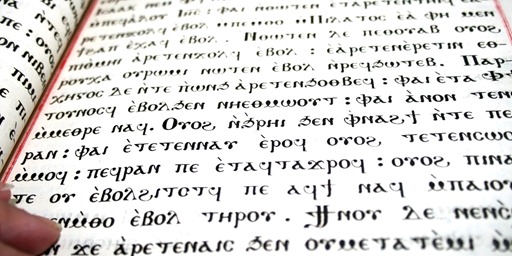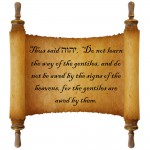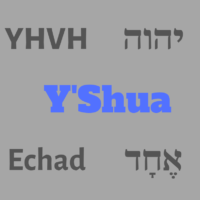Introduction
Most people in the Messianic movement end up here because of the fact that they want to think for themselves. Most people start to see through the false teachings that they have received from the formal religious institutions. This means that we like to figure things out for ourselves and verify what we are being taught by studying the topics on our own. The purpose of our website is to share with you as we learn. Thus, I hope that all of you will still keep on verifying what you read here and will speak up if you disagree with us. Even if you agree, please feel free to share any additional input you may have with us  via the comments section below each post. By doing this we will hopefully create a source of reference material that we can come back to whenever a specific topic comes up. It also creates a place where people new to this walk can come to find some information, thus please feel free to share this information with all the people that you meet.
via the comments section below each post. By doing this we will hopefully create a source of reference material that we can come back to whenever a specific topic comes up. It also creates a place where people new to this walk can come to find some information, thus please feel free to share this information with all the people that you meet.
Although we do a lot of Bible study to verify these things for ourselves, not many of us have been formally trained or instructed on the most effective ways to do Bible study. Please note that I did not say the correct way to do Bible study!    I do not believe that there exists a single method of Bible study that meets everybody’s requirements all the time. I myself use multiple methods and I adjust and mix these as I go along. If you become to rigid in your methodologies and methods, you will miss a lot of very good insight.
The topic of Bible study is too wide to cover in a single blog post. I will split the ideas that I have over a number of posts in order to give each of the topics sufficient air time. Please also note that I do not intend to compile a complete course on Bible study. That is way beyond the scope of what I have the capacity to currently deliver. I will provide an introduction to the topics, explain the key concepts and how it may impact our Bible study. I will also try to find an application out of this to allow you to find a way to immediately apply what we have found, to your own Bible study time. If it is appropriate I will provide some information or links to places where you can find additional information should you wish to study the topic further.
The sequence in which I plan to present the topics will follow a top-down approach. This term normally means we go from the highest level of abstraction into the lowest level of detail. So for Bible study this means we will first see what the Bible is, then what the books of the Bible are,  followed by the verses that make up a book and finally by the words that make up the specific verse. Some people prefer to go the other way, starting at the detail and then abstracting to the higher levels. Neither of the ways are more correct; it is simply personal preference. Thus, we will start our journey today by looking at the Bible as a whole.
When we talk about the Bible, what exactly does that mean? How much do you know about the history of the Bible text, the different translations out there in the world and the books that are included in and excluded from the Bible. I think this is a good place for us to start. Let’s get going.
Bible Translations
First question everybody will expect to get answered: what is the best Bible translation to use? I recently came across the perfect answer for this question: The one that you read every day! It is more important to read the Bible frequently from start to finish than it is to have the perfect translation (which I actually believe does not exist!) Having said this, I do want to explain the basics of Bible translation in order for you to have a better understanding of exactly what it is that you are reading.
Whenever you translate information from one language to another there is information that gets lost in the process. I personally speak more than one language and two of these languages are very similar with that same roots. However, even in this case you cannot simply do a mechanical conversion from the one vocabulary set to the other and then afterwards apply the grammar rules. Anybody that speaks more than one language will be able to verify this statement. This is also why tools like Google Translate does not always get it right. The further apart these languages are from one another, the more difficult the process becomes. Ask anybody that has translated Latin into Japanese!
The same thing happened to provide us with the Bible that we read every day. The authors of the various books of the Bible did not speak English! The words they wrote were not originally written in English. A majority of the Bible we have today has been recorded in either Hebrew, Aramaic or Greek. It took several decades and a lot of personal sacrifice for the first ever English translation to be published.
Whenever you open up two English translations of the Bible, you will very quickly find differences between the words or phrases in these translations. In order for you to know why these differences exist, it is important to understand a bit more about the translation process and all the thinking, discussing and decision making that has to gone into each translation of the Bible. If you become aware of these, you will also be able to better appreciate the words that you read in your Bible and then at the end come up with better Bible studies.
Source Texts
Whenever we have discussions about specific interpretations of Bible verses or words it does not take long for somebody to ask the question: But what does the original say? Very few people know exactly how complex the answer to this question is. It is not simply a question of jumping to the Hebrew or Greek and then we are back to the words the original author wrote. If only it was that simple!
When we talk about the original text, please note that we do not have an original manuscript of the Bible (Tanach or Apostolic Scriptures). The earliest evidence we have of a biblical text appears on the Silver Amulets discover at Ketef Himmon in 1979 dating to about 600 B.C. The oldest Hebrew manuscript was the Nash Papyrus that is a collection of papyrus fragments of a single sheet. Originally it was dated to 200 B.C but later this estimate was changed to 100 – 50 B.C. This documents contain the 10 commandments plus the start of the Shema. Then in 1947 a wonderful discovery was made in the caves near Khirbet Qumran. The collection of scrolls uncovered there became more widely known as the Dead Sea Scrolls. These caves contained the oldest known scrolls of the Biblical and extra-biblical documents ever discovered. The scrolls were written in Hebrew, Aramaic, Nabataean and Greek. The only book of the Tanach that was not represented in these scrolls were the book of Esther. Before the discovery of the Dead Sea Scrolls, the oldest Hebrew manuscripts of the Bible were Masoretic texts dating to 10th century A.C, such as the Aleppo Codex. Before the Dead Sea scrolls were found, the earliest extant manuscripts of the Tanach were manuscripts such as Codex Vaticanus Graecus 1209 and Codex Sinaiticus (both dating from the 4th century) that were written in Greek.
The first proof we have of any attempt to preserve and standardize the text of the Tanach is from around 500 B.C. when a group of teachers and interpreters of the Law called “sopherim†arose. They were called “sopherim†because they used to count (sfr) the letters of the text. There is no clear proof as to exactly what the source of the text was that this group used. The two main theories state that either a number of texts were merged into one or one singular source transformed into multiple versions. We know that from this time period three different families of text existed. These were the Palestine family (Samaritan Pentateuch, Masoretic Text of Chronicles and Several Qumran texts), Babylonian family (Masoretic text) and the Egyptian family (Septuagint). In the year 100 A.C the text was standardized by the scribes to what we today refer to as the Masoretic text. We know that significant difference exists between this standardized text from 100 A.C and the texts that were found at Qumran (300 – 100 B.C).  A  lot of very well educated people have spent their careers trying to determine the relationships between these different families of source text but yet no-one has come up with a final answer. What we need to learn from this is that even in the “originals†that we have of the Tanach, we already have differences.
We also have copies of the Tanach in other languages. These include the Septuagint (LXX) that is a Greek translation of the Tanach that was made between 250 and 100 B.C. The name Septuagint comes for the Latin word “septuagintaâ€Â which means 70. (LXX is the Roman numeral for 70). It  is probably derived from the “Letters of Aristeasâ€Â which states that 72 Jewish scholars translated the Tanach from Hebrew to Greek in 72 days by order of King Ptolemy for use in his library in Alexandria. This translation became more important as more believers in Y’Shua lived outside of Israel. It is estimated that in earlier years after the resurrection of Y’Shua, almost a million Jews lived in Egypt (Alexandria). The Septuagint became so popular that it was seen as the standard for the Tanach. The fact that this translation became so popular among the followers of Y’Shua was one of the reasons that the translation was later rejected by the Jewish people. The copies of the Septuagint translation that we have include the Codex Vaticanus (around 325-350 A.C.) which originally contained all the books of the Bible, the Codex Sinaiticus (around 330-360 B.C) which includes the Tanach, the Apochrypha, the Apostolic Scriptures part of the “Shepherd of Hermasâ€and “Epistle of Barnabasâ€. The Septuagint gives us a very reliable way to translate word between Hebrew and Greek. This is specifically useful if we try to determine how a specific concept was presented in the Tanach and then later in the Apostolic Scriptures.
Another language version is the Targums written in Aramaic. The name is derived from the Akkadian word “targumannum†meaning “translatorâ€. These translations originated from the need to have the Hebrew scriptures available in Aramaic. Some of the translations are very literal (Targum Onqelos) and others are very interpretive (Targum Neofiti). Targums exists for every book of the Tanach except Ezra, Nehemiah and Daniel. After the standardization of the Hebrew text in 100 A.C, the targums were also standardized with two official versions. Targum Onqelos for the Pentateuch and Targum Jonathan for the prophets. Technically speaking the targums are rather commentaries (due to the additions and interpretations) but still they provide us with a lot of knowledge about the Jewish interpretation and traditions during the first to third centuries.
Of the Apostolic Scriptures (New testament) we have around 57,000 fragments of manuscripts today. We also have no original (autograph) copies of any of the books in the Apostolic Scriptures. Several papyrus fragments date to the second century. One of the fragments of the Gospel of John is dated to early second century, around 75 years after the gospel was written. Among the early communities there were no formal scribes or groups responsible for the preservation of the text. This would explain why there are more mistakes in the copies of the Apostolic Scriptures than in the the Tanach. The forms of the letters used in these manuscripts is one of the major methods that is being used to date the manuscripts. The written Greek language changed from capital letters to Uncial letters (more cursive) to cursive and eventually to minuscule (smaller version of cursive). We have approximately 100 manuscripts in Uncial script and 2,754 in minuscule letters.
Also, in the Apostolic scriptures we find evidence of families of text. In the Greek text, the families of texts are mainly based on locality. We see the main groupings as Alexandrian, Ceasarean, Western and Byzantine. From all these families of fragments we have several “versions†of the Greek scriptures. The major version we have are the Complutensian Polyglot ( printed in 1514, published in 1520), the Textus Receptus ( meaning “received textâ€; published in 1516 and based on the Byzantine texts), the Novum Testamentum Graece (aka Nestle-Aland edition) which replaced the Textus Receptus was first published in 1898 and is currently in its 28th edition (NA28). The other version that is currently used for translations is the United Bible Societies’ Greek New Testament that was originally compiled in 1955 and is currently in it’s fourth revision. The text for both these version are the same, but the textual notes (textual apparatuses) do have differences.
In summary, as you can see from this, we simply cannot refer to the “original text†as s singular document that we can easily recall by looking up a specific reference number. That being said, the Bible is holy inspired scripture and YHVH has protected His messages through all these years and what we have today is His Word. A very experienced professional in the area of textual criticism, Daniel B. Wallace, made the following comment: “Only about 1% of the textual variants are both meaningful and relevantâ€. Thus 99% of all the difference we find in all the different textual families are actually irrelevant to the main message of the Scriptures.
Translation Philosophy
Once we have determined the source text of a translation, the translators have another major decision to make. This is referred to as the translation philosophy. Most Bible translations today follow one of the two approaches as a primary approach. These two approaches are called “Dynamic Equivalence†or “Formal Equivalenceâ€. They determine the approach the translators will take when converting the source text to the destination language.
When selecting the Dynamic Equivalence (functional Equivalence) principle, the translators will attempt to produce the same effect as the original text. This simply means that they will attempt to make the translation as literal as possible. They still need to ensure that the text is readable. The major approach for these translation are simplified as a “word-for-word†translation.
When selecting the Formal Equivalence principle the translators will attempt to transfer the concepts (phrases) in the source text, not the words. In this approach the translators rather look at a complete sentence and then attempt to get the concept of the sentence across to the target text. This means that the translators will attempt to paraphrase the original text based on their understanding of the text. This produces a translation that is much easier to read but further away from the original source texts.
Let us look at examples of the two extremes, pure dynamic Equivalence in Young’s Literal Translation and pure Formal Equivalence in The Message:
Genesis 1:1–2 (YLT)
1 In the beginning of YHVH’s preparing the heavens and the earth— 2the earth hath existed waste and void, and darkness is on the face of the deep, and the Spirit of YHVH fluttering on the face of the waters.Genesis 1:1–2 (The Message)
1–2 1 First this: YHVH created the Heavens and Earth—all you see, all you don’t see. Earth was a soup of nothingness, a bottomless emptiness, an inky blackness. YHVH’s Spirit brooded like a bird above the watery abyss.
Wow – what a difference! I cannot believe that these two translations started of with the same Hebrew words. Let us try and find some balance. Let us look at two translations that attempt to balance between these two principles:
Genesis 1:1–2 (NASB95)
1 In the beginning YHVH created the heavens and the earth.
2 The earth was formless and void, and darkness was over the surface of the deep, and the Spirit of YHVH was moving over the surface of the waters.Genesis 1:1–2 (NRSV)
1 In the beginning when YHVH created the heavens and the earth, 2 the earth was a formless void and darkness covered the face of the deep, while a wind from YHVH swept over the face of the waters.
Now what does it look like if we change the source to the Septuagint:
Genesis 1:1–2 (Brenton LXX En)
In the beginning YHVH made the heaven and the earth. 2 But the earth was unsightly and unfurnished, and darkness was over the deep, and the Spirit of YHVH moved over the water.
As you can see from all these versions, the texts of the translations may vary greatly, but they all convey the same message: YHVH created it all.
Theological Bias
The more the translators move from dynamic equivalence towards formal equivalence the more personal interpretation we see in the texts. When interpreting theological texts like the Bible, you cannot keep your paraphrasing clean from your own personal theological view. This means that even in the best case scenarios, we will find some traces of the translators personal doctrine in the eventual text. The best way to neutralize this is by ensuring that the translation is not the work of a single person. If the translation is done by a group of people, with separate teams of translators and reviewers, the changes are greatly improved for these personal views to be spotted and removed. Some translations, like the New American Standard, specifically chose the members of their translation team to represent as wide as possible spectrum of doctrines to ensure that the end product is as doctrine neutral as possible. However, I am not always certain that this ever fully achieved.
We also do find specific translations where a specific doctrine or theological bias is specifically used to create a version for a specific group of people. For the messianic community we have a number of these including “The Scriptures†and the “Complete Jewish Bibleâ€. The Scriptures was translated by a group of people while the latter is the work of one person, David Stern. I personally find both these translation useful (I use both of them in my studies) but I take note of their bias when I read the texts. Some other groups also have their own translations including the Roman Catholic Church that uses the New Jerusalem Bible.
What is added into the translations
In most translations we find words being added to the target language in order to make it more readable. As such this is not a wrong practice because in a lot of cases it takes more than one English word to accurately describe a Hebrew or Greek term. Let us look at an example
Genesis 1:3
3 Then Elohim said, “Let there be lightâ€; and there was light.
If we investigate the Hebrew being translated, we find that it was written in 8 words. The analysis below shows us which words have been added. We also see the number next the the Hebrew words that give us an indication of the original sequence of words. We see here that the words “Let there†and “there†is not in the Hebrew text. We also get an indication that these words were implied by the little arrows below the English word that show us which word implied these.
Thus, in this case we see the justification for the inclusion of these words as they were implied in the form of the Hebrew word. However, this is not always the case. In some cases we find words being added that are not implied, but are added because the translator( s ) believed that they would bring the message across clearer. This is normally where the theological bias starts playing a big role. In my previous post on the new High Priest, I pointed to exactly such an example that occurs in a number of translations.
Hebrews 8:7
7 For if that first covenant had been faultless, there would have been no occasion sought for a second.
In the source Greek text, we see that the word does not occur and is also not implied by any of the preceding or succeeding words in the sentence. It was purely added because the translators believed that the author of Hebrews is explaining to us the old covenant of keeping the commandments is inferior to the covenant of grace. As I explained in the article, this is not the case.
Another place where you will notice the theology of the translators, is in the periscopes. Periscopes are the titles and the sub-titles that the translators add at different points in the Bible to indicate the topics that are being discussed. As these titles and sub-titles do not exist in the source text, they are based purely upon the interpretation of the text by the translator ( s ). This is why we see some translation preferring not to add these at all. If we look at some of the translations that do decide to use these, the differences between the various translations should already give you a very good idea of how much interpretation and theology goes into these.
Also please take note that the source text, in a lot of the manuscripts, do not contain any punctuation or word separations. This also makes the interpretation of the older manuscripts more difficult. In the standardized Masoretic texts, these were added based on the understanding of these verses at the point of standardization. Let me show you a very basic illustration of what this means. If you saw the source manuscript stating “YHVHisnowhere†and you need to add word separation, do you make it “YHVH is nowhere†or do you make it “YHVH is now here� The context and the knowledge of the original language, as well as a thorough understanding of the complete Bible will allow the translator to correctly interpret the verse.
Another bit of interesting information – up until around 500 B.C, Greek was also written from right to left like Hebrew 1. Then it was written in alternating directions (one line left to right and then the next right to left). From about 500 B.C. Greek was written from right to left. This was most likely because the use of ink had become more common and this would be the most convenient for a right handed person.
Canon of the Bible
When you read your Bible, please remember that the Bible did not come to us as one complete book. What we did receive was a number of scrolls (or more accurate – fragments of scrolls) from different authors written at different times. The words of the prophets were preserved by the Jews as they knew that these were the words of YHVH. Thus, these books of the Tanach became part of the canon because of the authority assigned to them. They were not given authority because they were added to the canon. This concept is very well explained by F.F. Bruce in his book titled “The Books and the Parchmentsâ€. However, throughout the history there have been some discussions and arguments about the exact list of books that make up the Tanach. We have four main groupings here. They are Roman Catholic, Eastern Orthodox, Protestant and Jewish. These groups do not only disagree about which books, but also the sequence and groupings of the books.
The first time these scrolls were actually combined into a single binding of parchment must have been around the time that the Septuagint was compiled (250 – 100 B.C.). Before then, the idea of a single book had not yet really existed as the parchments were still too thick to be able to combine the complete Tanach into a single volume. Thus the early manuscripts of the Septuagint should give us an indication of what was considered inspired scripture. As we have mentioned before the Codex Vaticanus, Sinaiticus and Alexandrinus all date from around the fourth or fifth century. These all include some of the apocryphal books but there is no common list of books included. These books are also in different sequences in each codex. The Codex Alexandrinus, the “youngestâ€Â of the three also includes “Psalms of Solomon†that is considered to be Pseudepigrapha (written by a person other than the one mentioned in the title – thus not written by Solomon).
Apocrypha and Pseudepigrapha are extracanonical books that were written to describe the history and events of the Tanach. The Apocrypha is a list of around fifteen books including Tobit, Baruch, 1 & 2 Maccabees and 1 & 2 Esdras. Most of these were originally written in Hebrew or Aramaic and refer to characters in the Tanach. Several of these books were found with the Dead Sea Scrolls, but we have no proof that the Jews ever accepted any of these books as authorative. Arguments for the use of these books by early Christians included:
- Reference by the authors of the Apostolic Writings to these books. Jude (v14& 15) directly quotes 1 Enoch 1:9.
- The authors of the Apostolic Writings often quote from the Septuagint (not only the Hebrew Tanach). The earliest manuscripts of the Septuagint included books of the Apocrypha.
- Early church fathers (like Clement of Alexandria) accepted these books as authorative.
Arguments against these books include:
- Y’Shua never quoted from any of these books.
- None of these books claim to be the inspired word of YHVH.
- There are significant historical inaccuracies in the Apocrypha.
- There are theological inconsistencies (pre-existence of souls, praying to the dead, kindness to parents atones for sin, etc…)
However, if we except that the Bible is holy inspired scripture, we also need to accept that the process of adding books to the canon was also in the hands of YHVH. Thus I personally do not have any objections with reading these extracanonical books, but would not use any of these to base my theology or doctrine upon. If an extracanonical book contradicts what is in the Bible, I will always accept the Biblical book as correct.
Application
What can we conclude from all this information? We need to acknowledge that the Bible that we read today is the inspired word of YHVH. Even if we do not have any of the original texts, we still have the message that YHVH wanted us to have. He is in charge of all, including His Word.
However, we want to ensure that we get the most out of our time with the scriptures and do not want to be deceived in any way. Thus we need to find a practical way to get to the answer of “What is the right translation for me?†I would like to answer these questions for you in two steps.
First, find a translation that is easy for you to read. This is the Bible that you will use whenever you are simply “reading the Bibleâ€. The text should be clear to understand and easy to read. I personally use the “Complete Jewish Bible†for this purpose. It is not perfect, but it is easy to read and mostly free of replacement theology. It is also good to supplement this with David Sterns’ “The Jewish New Testament Commentary†as a commentary that is aligned with his translation. These are available in print and also electronically for most Bible Study software. This translation uses the Masoretic text and the UBS “The Greek New Testament†as it’s sources.
Although this is my preferred Bible for reading it is not the one that I use for detailed Bible study. When it comes to in-depth study and questions about doctrine I follow another approach. Here I believe that it is good to have more than one translation and then compare. I use a variety of translations including
- New American Standard (Updated Edition of 1995) – this is a fairly modern translation that leans towards the dynamic (literal) side of the spectrum, it is still readable and understandable for most people. This is also the version that we use per default in all our articles on this blog.
- Young’s Literal Translation – This provides me with the literal side of the spectrum. The translation is dated and difficult to read but it does a good job of doing a very literal translation (as the name states)
- The Jewish Publication Society’ Tanakh (1985 Edition) – provides me with a Jewish perspective of the text. Good to balance out some of the Christian doctrine found in the other translations.
- The Septuagint Version of the Old Testament: English Translation – This is a version of the Tanakh based on the Septuagint. Allows me to get the Greek to English translation for the Tanakh.
These are the primary ones that I use. On the standby list I include:
- The Scriptures
- New Revised Standard Version
- English Standard version
- The Lexham English Bible (4th Edition – 2012) based on Biblia Hebraica Stuttgartensia and The Greek New Testament: SBL Edition
One thing you need to ensure that you have on your list is what is called a Reverse-Interlinear Version of the Bible. This is a version of your translation that allows you to look at the source text as well (when needed). I am not referring to a Bible that is simply coded to a concordance (e.g. Strong’s numbers). I am referring to a Bible that allows you to see:
- The Original word (MSS)
- The lemma (root) of the word
- The Morphology – e.g. what tense is the verb in, singular/plural, feminine/masculine and 1st/3rd Person.
- Sequence of the words
This tool will allow you to get a better understanding and appreciation for the English translations you are reading.
Most of these translations are available for most Bible Study programs. You can also find hard copies, but these are fairly pricy and very bulky.
If you are looking for a way to compare a few different translations, you can also use online services like BibleGateway and Biblia.
Conclusion
I hope I have provided you with some more information on the what it is that you read when you read your Bible in English. The more I understand the complexity of a Bible translation, the more I appreciate the wonder of YHVH protecting His message through all the centuries.
By understanding what it is that I am reading, I can ensure that the methods that I use give me the best possible insight to what it is that YHVH is trying to tell me.
You need to remember that reading the Bible is not like reading any other book you may own. It is inspired Scripture! If you want to ensure that you are doing it right, please spend time in prayer whenever you are studying the Word. Let YHVH speak directly to you via His Word.
If you find this topic interesting and would like to read some more, I can recommend the following book as a good place to start – The Journey from texts to Translations
Please let us know what other translations you are using and what you find good about the specific translation by leaving a comment below this article.
Continue to Bible Study – Part 2Â – Getting to know the books of the Bible
References
1. Wegner, Paul D; The Journey from texts to Translations; p87; A BridgePoint book; ISBN 0-8010-2169-3












Leave a Reply